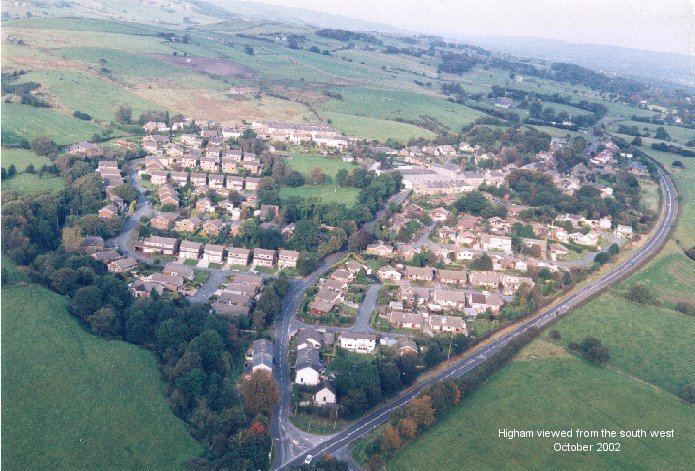Population 778 Sovereign state United Kingdom Dialling code 01282 | OS grid reference SD805365 Local time Saturday 10:33 AM UK parliament constituency Pendle | |
 | ||
Civil parish Higham with West Close Booth Weather 9°C, Wind S at 16 km/h, 91% Humidity | ||
Higham is a village in the Borough of Pendle in Lancashire, England, south of Pendle Hill. The civil parish is named Higham with West Close Booth. The village is 2 miles (3 km) north-east of Padiham and about 4 miles (6 km) south west of Nelson along the A6068 road.
Contents
Map of Higham, Burnley, UK
According to the United Kingdom Census 2011, the parish has a population of 778, a decrease from 808 in the 2001 census.
The parish adjoins the other Pendle parishes of Goldshaw Booth, Old Laund Booth and Reedley Hallows, the Burnley parishes of Ightenhill and Padiham, and the Ribble Valley parishes of Simonstone and Sabden. The area of the parish north of Stump Hall Road is part of the Forest of Bowland Area of Outstanding Natural Beauty (AONB).
Governance
Higham with West Close Booth was once a township in the ancient parish of Whalley. This became a civil parish in 1866, forming part of the Burnley Rural District from 1894. The township included a detached area south of the village of Fence, but this part transferred to Old Laund Booth in 1898. A part of the parish also transferred to Sabden on its creation in 1904.
Along with Goldshaw Booth, Barley-with-Wheatley Booth and Roughlee Booth, the parish forms the Higham with Pendleside ward of Pendle Borough Council.
Facilities
The centre of Higham is a conservation area. The buildings in the area are stone-built mainly from the 19th century with a few older. Several farmhouses and barns have been converted to houses. Outside the Conservation Area most buildings are from later periods including modern housing estates.
Amenities include a pub, the Four Alls Inn, est. 1798 where you can discover the meaning of "Four Alls"; the Church of St John the Evangelist (C of E) built 1874, Higham C of E (Controlled) Primary School, and the Village Hall.
Buildings and features
The Spout is a feature in the centre of the village, providing constantly running natural spring water. Nearby is the historic site of a pinfold or poundfield, a walled area with grass and running water which was used to temporarily impound animals.
Other buildings of note include the village hall, 1837, which was built as the National School and also used for Church of England services until St John's Church was built. Higham Hall, 17th century, used for meetings of the court of the Forest of Pendle. Clover Croft Mill stood in the centre of the village having latterly been used as a furniture factory. The demolition was completed in 2006 to enable a housing development to be built on the site.
On the road to Nelson are three buildings of interest: Lower White Lee (18th century), Higher White Lee birthplace of Jonas Moore (see below), Ashlar House has a porch dated 1594 with the names Richard Grimshaw and John Box, but the house seems to have been rebuilt in the 17th century.
